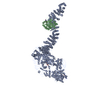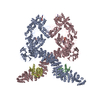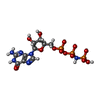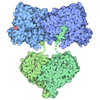[English] 日本語
 Yorodumi
Yorodumi- PDB-8vh5: Cryo-EM structure of Rab12-LRRK2 complex in the LRRK2 dimer state -
+ Open data
Open data
- Basic information
Basic information
| Entry | Database: PDB / ID: 8vh5 | ||||||||||||||||||||||||||||||||||||
|---|---|---|---|---|---|---|---|---|---|---|---|---|---|---|---|---|---|---|---|---|---|---|---|---|---|---|---|---|---|---|---|---|---|---|---|---|---|
| Title | Cryo-EM structure of Rab12-LRRK2 complex in the LRRK2 dimer state | ||||||||||||||||||||||||||||||||||||
 Components Components |
| ||||||||||||||||||||||||||||||||||||
 Keywords Keywords | HYDROLASE / Cryo-EM / Parkinson's disease / Kinase / LRRK2 / Rab GTPases | ||||||||||||||||||||||||||||||||||||
| Function / homology |  Function and homology information Function and homology informationRab protein signal transduction / caveola neck / : / beta-catenin destruction complex binding / regulation of branching morphogenesis of a nerve / Wnt signalosome assembly / regulation of kidney size / regulation of cell projection organization / tangential migration from the subventricular zone to the olfactory bulb / GTP-dependent protein kinase activity ...Rab protein signal transduction / caveola neck / : / beta-catenin destruction complex binding / regulation of branching morphogenesis of a nerve / Wnt signalosome assembly / regulation of kidney size / regulation of cell projection organization / tangential migration from the subventricular zone to the olfactory bulb / GTP-dependent protein kinase activity / regulation of SNARE complex assembly / regulation of neuroblast proliferation / regulation of ER to Golgi vesicle-mediated transport / protein localization to endoplasmic reticulum exit site / peroxidase inhibitor activity / negative regulation of late endosome to lysosome transport / regulation of mitochondrial depolarization / : / positive regulation of dopamine receptor signaling pathway / amphisome / regulation of synaptic vesicle transport / regulation of lysosomal lumen pH / regulation of CAMKK-AMPK signaling cascade / co-receptor binding / negative regulation of GTPase activity / regulation of dopamine receptor signaling pathway / positive regulation of microglial cell activation / regulation of neuron maturation / regulation of retrograde transport, endosome to Golgi / positive regulation of synaptic vesicle endocytosis / negative regulation of excitatory postsynaptic potential / cytoplasmic side of mitochondrial outer membrane / negative regulation of autophagosome assembly / olfactory bulb development / JUN kinase kinase kinase activity / neuron projection arborization / RAB geranylgeranylation / striatum development / multivesicular body, internal vesicle / trans-Golgi network transport vesicle / regulation of dendritic spine morphogenesis / mitochondrion localization / protein localization to mitochondrion / RAB GEFs exchange GTP for GDP on RABs / endocytic recycling / cellular response to dopamine / positive regulation of mitochondrial outer membrane permeabilization involved in apoptotic signaling pathway / endoplasmic reticulum organization / positive regulation of protein autoubiquitination / Wnt signalosome / negative regulation of protein processing / positive regulation of programmed cell death / GTP metabolic process / regulation of canonical Wnt signaling pathway / syntaxin-1 binding / regulation of reactive oxygen species metabolic process / lysosome organization / Golgi-associated vesicle / clathrin binding / PTK6 promotes HIF1A stabilization / negative regulation of macroautophagy / endosome to lysosome transport / neuromuscular junction development / regulation of cAMP/PKA signal transduction / regulation of mitochondrial fission / protein kinase A binding / regulation of locomotion / regulation of synaptic vesicle exocytosis / Golgi organization / intracellular distribution of mitochondria / microvillus / exocytosis / exploration behavior / endoplasmic reticulum exit site / autolysosome / locomotory exploration behavior / negative regulation of Notch signaling pathway / regulation of synaptic vesicle endocytosis / MAP kinase kinase kinase activity / canonical Wnt signaling pathway / regulation of synaptic transmission, glutamatergic / negative regulation of endoplasmic reticulum stress-induced intrinsic apoptotic signaling pathway / Rho protein signal transduction / presynaptic cytosol / neuron projection morphogenesis / phagocytic vesicle / cellular response to manganese ion / JNK cascade / positive regulation of autophagy / dendrite cytoplasm / autophagosome / tubulin binding / GTPase activator activity / cellular response to starvation / positive regulation of protein ubiquitination / small monomeric GTPase / SNARE binding / determination of adult lifespan / regulation of membrane potential / cellular response to reactive oxygen species Similarity search - Function | ||||||||||||||||||||||||||||||||||||
| Biological species |  Homo sapiens (human) Homo sapiens (human) | ||||||||||||||||||||||||||||||||||||
| Method | ELECTRON MICROSCOPY / single particle reconstruction / cryo EM / Resolution: 4 Å | ||||||||||||||||||||||||||||||||||||
 Authors Authors | Zhu, H. / Sun, J. | ||||||||||||||||||||||||||||||||||||
| Funding support |  United States, 1items United States, 1items
| ||||||||||||||||||||||||||||||||||||
 Citation Citation |  Journal: Nat Commun / Year: 2024 Journal: Nat Commun / Year: 2024Title: RAB12-LRRK2 complex suppresses primary ciliogenesis and regulates centrosome homeostasis in astrocytes. Authors: Xingjian Li / Hanwen Zhu / Bik Tzu Huang / Xianting Li / Heesoo Kim / Haiyan Tan / Yuanxi Zhang / Insup Choi / Junmin Peng / Pingyi Xu / Ji Sun / Zhenyu Yue /    Abstract: The leucine-rich repeat kinase 2 (LRRK2) phosphorylates a subset of RAB GTPases, and their phosphorylation levels are elevated by Parkinson's disease (PD)-linked mutations of LRRK2. However, the ...The leucine-rich repeat kinase 2 (LRRK2) phosphorylates a subset of RAB GTPases, and their phosphorylation levels are elevated by Parkinson's disease (PD)-linked mutations of LRRK2. However, the precise function of the LRRK2-regulated RAB GTPase in the brain remains to be elucidated. Here, we identify RAB12 as a robust LRRK2 substrate in the mouse brain through phosphoproteomics profiling and solve the structure of RAB12-LRRK2 protein complex through Cryo-EM analysis. Mechanistically, RAB12 cooperates with LRRK2 to inhibit primary ciliogenesis and regulate centrosome homeostasis in astrocytes through enhancing the phosphorylation of RAB10 and recruiting RILPL1, while the functions of RAB12 require a direct interaction with LRRK2 and LRRK2 activity. Furthermore, the ciliary and centrosome defects caused by the PD-linked LRRK2-G2019S mutation are prevented by Rab12 deletion in astrocytes. Thus, our study reveals a physiological function of the RAB12-LRRK2 complex in regulating ciliogenesis and centrosome homeostasis. The RAB12-LRRK2 structure offers a guidance in the therapeutic development of PD by targeting the RAB12-LRRK2 interaction. | ||||||||||||||||||||||||||||||||||||
| History |
|
- Structure visualization
Structure visualization
| Structure viewer | Molecule:  Molmil Molmil Jmol/JSmol Jmol/JSmol |
|---|
- Downloads & links
Downloads & links
- Download
Download
| PDBx/mmCIF format |  8vh5.cif.gz 8vh5.cif.gz | 795.9 KB | Display |  PDBx/mmCIF format PDBx/mmCIF format |
|---|---|---|---|---|
| PDB format |  pdb8vh5.ent.gz pdb8vh5.ent.gz | 617.9 KB | Display |  PDB format PDB format |
| PDBx/mmJSON format |  8vh5.json.gz 8vh5.json.gz | Tree view |  PDBx/mmJSON format PDBx/mmJSON format | |
| Others |  Other downloads Other downloads |
-Validation report
| Summary document |  8vh5_validation.pdf.gz 8vh5_validation.pdf.gz | 1.7 MB | Display |  wwPDB validaton report wwPDB validaton report |
|---|---|---|---|---|
| Full document |  8vh5_full_validation.pdf.gz 8vh5_full_validation.pdf.gz | 1.7 MB | Display | |
| Data in XML |  8vh5_validation.xml.gz 8vh5_validation.xml.gz | 123.1 KB | Display | |
| Data in CIF |  8vh5_validation.cif.gz 8vh5_validation.cif.gz | 194.7 KB | Display | |
| Arichive directory |  https://data.pdbj.org/pub/pdb/validation_reports/vh/8vh5 https://data.pdbj.org/pub/pdb/validation_reports/vh/8vh5 ftp://data.pdbj.org/pub/pdb/validation_reports/vh/8vh5 ftp://data.pdbj.org/pub/pdb/validation_reports/vh/8vh5 | HTTPS FTP |
-Related structure data
| Related structure data |  43235MC  8vh4C M: map data used to model this data C: citing same article ( |
|---|---|
| Similar structure data | Similarity search - Function & homology  F&H Search F&H Search |
- Links
Links
- Assembly
Assembly
| Deposited unit | 
|
|---|---|
| 1 |
|
- Components
Components
-Protein , 2 types, 4 molecules ACBD
| #1: Protein | Mass: 286427.656 Da / Num. of mol.: 2 Source method: isolated from a genetically manipulated source Source: (gene. exp.)  Homo sapiens (human) / Gene: LRRK2, PARK8 / Production host: Homo sapiens (human) / Gene: LRRK2, PARK8 / Production host:  Homo sapiens (human) Homo sapiens (human)References: UniProt: Q5S007, non-specific serine/threonine protein kinase, Hydrolases; Acting on acid anhydrides; Acting on GTP to facilitate cellular and subcellular movement #2: Protein | Mass: 20207.365 Da / Num. of mol.: 2 Source method: isolated from a genetically manipulated source Source: (gene. exp.)  Homo sapiens (human) / Gene: RAB12 / Production host: Homo sapiens (human) / Gene: RAB12 / Production host:  |
|---|
-Non-polymers , 4 types, 8 molecules 






| #3: Chemical | | #4: Chemical | #5: Chemical | #6: Chemical | |
|---|
-Details
| Has ligand of interest | Y |
|---|---|
| Has protein modification | N |
-Experimental details
-Experiment
| Experiment | Method: ELECTRON MICROSCOPY |
|---|---|
| EM experiment | Aggregation state: PARTICLE / 3D reconstruction method: single particle reconstruction |
- Sample preparation
Sample preparation
| Component | Name: Rab12-LRRK2 / Type: COMPLEX / Entity ID: #1-#2 / Source: RECOMBINANT |
|---|---|
| Source (natural) | Organism:  Homo sapiens (human) Homo sapiens (human) |
| Source (recombinant) | Organism:  Homo sapiens (human) Homo sapiens (human) |
| Buffer solution | pH: 8 |
| Specimen | Embedding applied: NO / Shadowing applied: NO / Staining applied: NO / Vitrification applied: YES |
| Vitrification | Cryogen name: ETHANE |
- Electron microscopy imaging
Electron microscopy imaging
| Experimental equipment |  Model: Titan Krios / Image courtesy: FEI Company |
|---|---|
| Microscopy | Model: FEI TITAN KRIOS |
| Electron gun | Electron source:  FIELD EMISSION GUN / Accelerating voltage: 300 kV / Illumination mode: OTHER FIELD EMISSION GUN / Accelerating voltage: 300 kV / Illumination mode: OTHER |
| Electron lens | Mode: BRIGHT FIELD / Nominal magnification: 130000 X / Nominal defocus max: 2600 nm / Nominal defocus min: 1200 nm |
| Image recording | Electron dose: 77.6 e/Å2 / Film or detector model: GATAN K3 (6k x 4k) |
- Processing
Processing
| EM software |
| ||||||||||||||||||||||||
|---|---|---|---|---|---|---|---|---|---|---|---|---|---|---|---|---|---|---|---|---|---|---|---|---|---|
| CTF correction | Type: PHASE FLIPPING AND AMPLITUDE CORRECTION | ||||||||||||||||||||||||
| Symmetry | Point symmetry: C2 (2 fold cyclic) | ||||||||||||||||||||||||
| 3D reconstruction | Resolution: 4 Å / Resolution method: FSC 0.143 CUT-OFF / Num. of particles: 77265 / Symmetry type: POINT | ||||||||||||||||||||||||
| Refine LS restraints |
|
 Movie
Movie Controller
Controller



 PDBj
PDBj

























